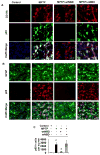Testing NF-κB-based therapy in hemiparkinsonian monkeys
- PMID: 22661311
- PMCID: PMC3419771
- DOI: 10.1007/s11481-012-9377-9
Testing NF-κB-based therapy in hemiparkinsonian monkeys
Abstract
Parkinson's disease (PD) is the most common human neurodegenerative disorder affecting movement, balance, flexibility, and coordination. Despite intense investigation, no effective therapy is available to stop the onset PD or halt its progression. The primate model of PD is considered to be one of the best available models for human PD. Since neuroinflammation plays an important role in the pathogenesis of PD and NF-κB, a proinflammatory transcription factor, participates in the transcription of many proinflammatory molecules, this study evaluates the ability of a peptide corresponding to the NF-κB essential modifier (NEMO)-binding domain (NBD) of IκB kinase (IKK)α or IKKβ to protect dopaminergic neurons in hemiparkinsonian monkeys. First, we found that NF-κB was activated within the substantia nigra pars compacta of 1-methyl-4-phenyl-1,2,3,6-tetrahydropyridine (MPTP)-intoxicated hemiparkinsonian monkeys. However, intramuscular injection of wild type NBD (wtNBD) peptide reduced nigral activation of NF-κB and expression of inducible nitric oxide synthase, protected both the nigrostriatal axis and neurotransmitters, and improved motor functions in hemiparkinsonian monkeys. These findings were specific as mutated NBD peptide did not exhibit such effects. These results may help in the translation of NF-κB-based therapy to PD clinics.
Conflict of interest statement
Figures








References
-
- Collier TJ, Steece-Collier K, Kordower JH. Primate models of Parkinson’s disease. Exp Neurol. 2003;183:258–262. - PubMed
-
- Dauer W, Przedborski S. Parkinson’s disease: mechanisms and models. Neuron. 2003;39:889–909. - PubMed
-
- Dehmer T, Lindenau J, Haid S, Dichgans J, Schulz JB. Deficiency of inducible nitric oxide synthase protects against MPTP toxicity in vivo. J Neurochem. 2000;74:2213–2216. - PubMed
-
- Emborg ME, Shin P, Roitberg B, Sramek JG, Chu Y, Stebbins GT, Hamilton JS, Suzdak PD, Steiner JP, Kordower JH. Systemic administration of the immunophilin ligand GPI 1046 in MPTP-treated monkeys. Exp Neurol. 2001;168:171–182. - PubMed
Publication types
MeSH terms
Substances
Grants and funding
LinkOut - more resources
Full Text Sources
Other Literature Sources
Miscellaneous

